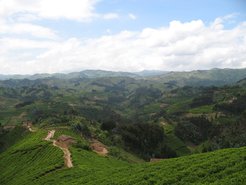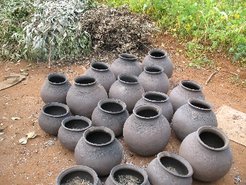Current Project
Integration and marginalisation in Rwanda: The case of the Twa
‘While it is important to keep alive the memory of the genocide and those who were killed, we Rwandans need to work hard to overcome our country’s bad history, and together forge a new identity in order to succeed as a nation.’ (President Paul Kagame during National Commemoration 2009)
The Setting

With the genocide of 1994, Rwanda - a small country in Eastern Central Africa – has come into the focus of worldwide attention. An estimated 800.000 people perished in the massacres, and the following mass exodus of Rwandans (among them many perpetrators of genocide) saw hundreds of thousands fleeing mostly to neighbouring Zaire (today Democratic Republic of Congo) or Tanzania. Although the events in Rwanda contributed much to the following and persistent instability in the Great Lakes region (for example the Congo wars 1996 – 2003), Rwanda’s reconstruction is today being considered a success story, especially in terms of regional integration and economic development. Apart from aiming at progress and stability, the Rwandan Government of National Unity under the leadership of current President Paul Kagame is determined to rebuild the Rwandan nation and to reconcile a once deeply divided population. Reconciliation is sought through various institutions and ‘home-grown’ solutions: Neo-traditional Gacaca courts, for example, are institutions not only dealing with crimes committed during genocide but also seeking to establish the truth about the events of 1994 and serving as forum to forgive and confess guilt. The National Unity and Reconciliation Commission (NURC) implements a range of civic education programmes for former combatants, but students, teachers, and local authorities as well. An important component of those programmes and the unification policy is the ‘forging’ of a new national identity for all Rwandans (Banyarwanda). The roots of such a common national identity are located in a peaceful pre-colonial past where the three main social groups Hutu, Tutsi, and Twa are depicted as having lived together as one, in synergy and peace. The interpretation of Rwandan social groups as ethnic groups – a perception that was at the core of genocidal ideology – is considered a colonial invention. In the Rwanda of today, referring to ethnicity or identity categories such as Hutu, Tutsi, or Twa is hence considered as spreading divisionism, as a danger to the ongoing reconciliation and unification process.
Apart from aiming at progress and stability, the Rwandan Government of National Unity under the leadership of current President Paul Kagame is determined to rebuild the Rwandan nation and to reconcile a once deeply divided population. Reconciliation is sought through various institutions and ‘home-grown’ solutions: Neo-traditional Gacaca courts, for example, are institutions not only dealing with crimes committed during genocide but also seeking to establish the truth about the events of 1994 and serving as forum to forgive and confess guilt. The National Unity and Reconciliation Commission (NURC) implements a range of civic education programmes for former combatants, but students, teachers, and local authorities as well. An important component of those programmes and the unification policy is the ‘forging’ of a new national identity for all Rwandans (Banyarwanda). The roots of such a common national identity are located in a peaceful pre-colonial past where the three main social groups Hutu, Tutsi, and Twa are depicted as having lived together as one, in synergy and peace. The interpretation of Rwandan social groups as ethnic groups – a perception that was at the core of genocidal ideology – is considered a colonial invention. In the Rwanda of today, referring to ethnicity or identity categories such as Hutu, Tutsi, or Twa is hence considered as spreading divisionism, as a danger to the ongoing reconciliation and unification process.
The research question

National unity, integration and the progressing new Rwanda are prominent topics in the current Rwandan socio-political discourses. Frequently, Rwanda is portrayed as a state that treats all citizens equally and is about to overcome the shadows of a divided past.
But there are nuances and inconsistencies in the shiny picture, and one example for such a nuance could be the Twa. In older accounts, Twa were usually described as a minority group, constituting less than 1% of the Rwandan population and living as either hunter-gatherers and potters or clients at the king’s court. Their social status was considered as low, even pariah-like.
In present-day Rwanda - with the extensive unification policy of the government – they are no longer referred to as Twa but citizens of the Rwandan state, albeit vulnerable and ‘historically marginalised’ ones. Pottery and day-labour remain the main source of income, the majority lives in abject poverty without access to resources like land. As such, the Twa are classified among the target audience of several development schemes dealing with proper housing and health care for vulnerable groups. But the Twa or historically marginalised people (abahejejwe inyuma n’amateka) have also been depicted as the autochthonous inhabitants of Rwanda by local and international lobby organisations or human rights bodies, a claim with considerable potential for conflict between organisations and the Rwandan authorities.
The research project in the context of Department I (‘Integration and Conflict’) seeks to examine the stakeholders and structures of current socio-political discourses in Rwanda that deal with reconciliation, national identity and unity. It will be asked which conceptions of ‘the Twa’ inform development schemes and state programmes targeting vulnerable groups and what effects those programmes have on life in the communities. In that respect, the work of NGOs lobbying for the rights of the Twa – then often perceived as an autochthonous group – and their interactions with local authorities will be examined as well.
Field research has focused predominantly on Rwanda but data on specific events and configurations in neighbouring countries such as Burundi or the DRC will be included into the analysis, too.

